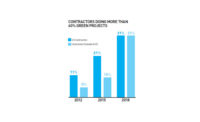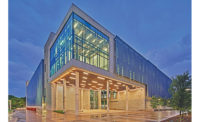Identified Risk: An increased risk of falling comes from a more ladder time installing added wires and controls, and double caulking.
Suggested Mitigation: Designers could incorporate prefabricated panels of the exterior skin system, framing, structure and vapor barrier, and contractors could caulk from the building’s interior before installing finishing materials.
LEED Credit: On-Site Renewable Energy
Identified Risk: Falls and overexertion are more likely from installing heavy PV panels, usually on the roof.
Suggested Mitigation: Designers could place PV panels closer to the ground or keep them as far from the edge of the roof as possible. Higher parapets and designed tie-off points may also lessen the risk of falling.
LEED Credit: Enhanced Commissioning
Identified Risk: The presence of commissioners distracts workers, increasing risk of falls and injuries.
Suggested Mitigation: Commissioning agents could receive a site-specific orientation and be provided with personal protective equipment. Agents could be required to pass an OSHA safety course.
LEED Credit: Construction Waste Management
Identified Risk: “Dumpster diving” to retrieve mistakenly trashed recyclable materials increases risk of sprains and cuts.
Suggested Mitigation: Suggested solutions include utilizing a third-party, local waste management company to sort the recyclable material offsite, using multiple, smaller waste receptacles around the construction site, or creating an industry-wide, color-coded labeling system to differentiate recycling from trash.
LEED Credit: Outdoor Air Delivery Monitoring
Identified Risk: Time spent at heights to wire and mount the permanent monitoring system increases risk of falls.
Suggested Mitigation: This risk may be eliminated by incorporating the monitoring equipment into the prefabrication process.
LEED Credit: Construction IAQ Management Plan




Post a comment to this article
Report Abusive Comment